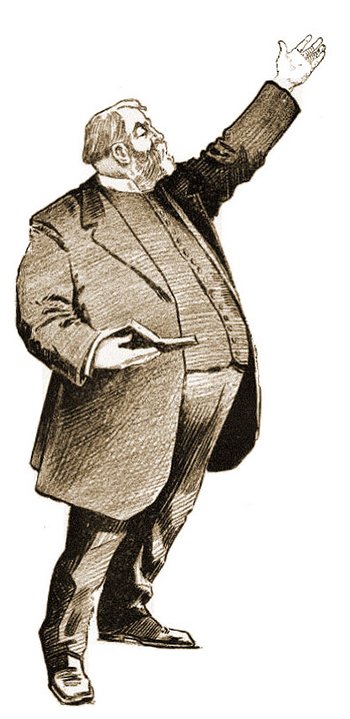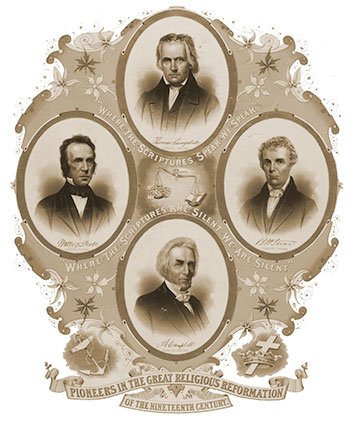Wheaton College Revival 1950
TIME MAGAZINE – FEBRUARY 20, 1950
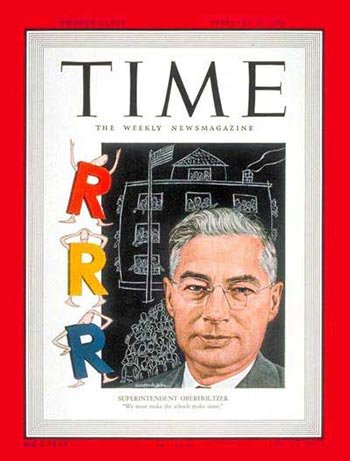
Time Magazine 20th Feb. 1950
42 Hours of Repentance
Just after dinner one evening last week, balding, spectacled President Victor Raymond Edman of Illinois’ Wheaton College rose to begin a regular session of the Evangelistic Week that traditionally begins each term. Stepping up to the microphones in the brightly lit, rectangular auditorium of Pierce Memorial Chapel, he asked if any student would, ‘like to give a word of testimony or praise on the blessings of this week.’
President Edman was not surprised when several students trooped up to the rostrum.” (Students were asked to come and sit in the choir loft and move over and down one by one, after it became evident that too many were standing and waiting for too long, to testify or confess, but the reporters didn’t get there the first day. They came the second night). Such impromptu declarations are not unusual at Wheaton, a little (1,300 students), non-denominational college which still bears the stamp of its strict fundamental heritage: no movies, smoking, card playing, dancing or drinking, a 10 p.m. curfew. But as the first students finished speaking, a surge of confessional fervor swept through the auditorium.
Christ or Baseball?
Singly and in little groups, sweatered and blue-jeaned undergraduates streamed onto the stage, filling up the choir chairs to await their turn. Hour after hour they kept coming. All night long, all the next day, all through the following night, and half the following day, students poured out confessions of past sins and rededicated themselves to God.
The auditorium filled up and overflowed into a smaller chapel downstairs. Classes had to be cancelled altogether. Some speakers came forward boldly and eagerly; other were so overcome with shyness they had to abandon the attempted come back later to try again. Some broke down completely.
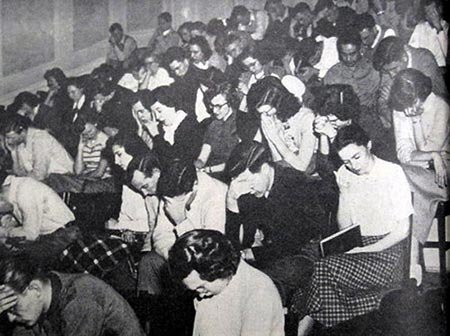
Repentance amongst Wheaton students
Said one young man, ‘I have to confess that in the pass I felt undue pride in my membership in the Men’s Glee Club, and tended to look down on members of the Gospel Choir.’ Sniffled a determined brunette: ‘I want to say this publicly so that those who hear me will know I mean business. I know it’s mostly the fellows who say they have impure thoughts, but girls have them too. And I want to apologize if I’ve ever tempted any of the fellows I’ve had contact with. I know I’ve tried, and I’m sorry.’ Said a young man with a Brooklyn accent, ‘I want to apologize for making the faculty the butt of my corny jokes…I want to get something else off my chest: giving thanks for food and then complaining about it.’
‘Twenty-four hours ago,’ declared a cheerful, ruddy baseball star, ‘This is the last thing I thought I’d be doing…Last night I looked in my yearbook, and after my name it said baseball is my main interest. I want to say: Christ is my main interest.’
Probing of the Heart.
One girl both committed her, ‘sin,’ and asked pardon for it while at the microphone. Many of her fellow students, she said, were ‘silly to give testimony,’ because she couldn’t believe they were sincere; then she asked forgiveness for doubting their sincerity. A spare young faculty member rose to confess: ‘I’ve led a double life. I’ve lived a life of defeat…As you know, I was once a missionary in China. After the war started, I came back. I told people it was because of the war. But it wasn’t…It was because I didn’t want to go on being a missionary…I want you to pray for me so my life will really tell for God.’
There was little audible response to the confessions. Here & there, listeners sat with their heads in their hands. Patiently through all most all of it, waited the Rev. Edwin Johnson of Seattle’s First Mission Covenent Church, who, as leader of the Evangelistic Week, had been scheduled to address the group the night it all began. At last, President Edman gave him his chance at the microphone. ‘We’ve seen a probing of the heart today such as we’ve never seen before,’ said Johnson.
But when other confession-hungry heart probers began flocking to Wheaton–followed by the simply curious–President Edman discretely ended the public testimonies. After a few hours more of confessions, it was all over. 47 hours and 40 minutes after it started. ‘These kids are tired out,’ explained weary President Edman. ‘The testimonies have mostly to do with private matters. After all, the principle confessions are to Almighty God, not a public audience.’
1st Great Awakening 1727
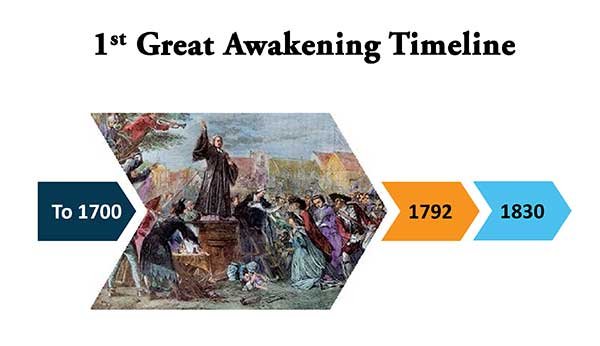
1st Great Awakening
Pietism: Prelude to the Revival
‘A people’s movement which emphasized an internal and individual return of the soul to the authority of the Bible, to prayer and to piety.’
1661 Philipp Jakob Spener (1635-1705), ‘Father of Pietism,’ Lutheran pastor in Frankfurt, organanised meetings called ‘collegia pietatis’ (small groups) for his converts.
1675 Spener published Pia Desideria (“Pious Desires”), Pietist training for leaders.
1692 August Hermann Francke (1663-1727), a kindred spirit to Spener, who arranged an appointment for Francke as professor in the University of Halle, opened in 1691. Helped to make Halle a pietistic center of higher education and revivalism. Franke had immense influence across Europe and America.
1706 The first two Protestant missionaries were Pietists, Bartholomew Ziegenbalg (1682-1719) and Heinrich Plütschau (1677-1747). Sent in by the King Frederick IV of Denmark to begin missionary work in southern India.
1719 After 13 years 428 persons had been baptized and 280 received into membership in the new church in southern India.
1734 Johann A. Bengel (1687-1752) published a New Testament text with critical apparatus to further August Francke’s emphasis on biblical study.
Revival stirrings and influences
1679,1683,1696,1712,1718 Solomon Stoddard (1643-1729), Jonathan Edwards’s grandfather, pastor of Congregational Church in Northampton, Mass. From 1670 until his death, he was an earnest soul-winner who had five “harvests” (revivals) in his church. (Jonathan Edwards’ ‘Faithful Narrative’. Also recorded in Gillies.
1705 Revival at Taunton, Mass., when a group met for fasting and prayer, prompted by the example of religious societies of young men in London, to promote a ‘reformaton’ to counteract growing godlessness in the town. (Gillies)
1721 Local revival at Windham, Connecticut. (Gillies)
1726 William Tennent began The Log College, producing many revivalist preachers.
1726 Gilbert Tennent, Presbyterian revival in New Brunswick, New Jersey.
1727 Theodore Frelinghuysen, a Dutch Reformed Pietist, saw revival in Dutch Reformed churches of the Raritan River Valley in New Jersey.
1732 John and William Tennent (sons of William Tennent) revival at Freehold, New Jersey.
1739 Samuel Blair became pastor of Fagg’s Manor, 40 miles southwest of Philadelphia, set up a school similar to Tennent’s Log College Tennent. Two notable students were James Finley and Samuel Davies, the organizer of Presbyterianism in Virginia.
Moravians and Nikolas Count Ludwig Von Zinzendorf
1727 August 13, Revival at Moravian Church in Herrnhut.
1732 First Moravian missionaries sent to the West Indies.
1738 Peter Bohler, a faithful Moravian leader, with John Wesley, organized a society in London.
American Revivals
1734 Revival at Northampton, Mass under Jonathan Edwards. The revival spread up and down the Connecticut River valley until over one hundred communities had experienced renewal of Christians and salvation of sinners by 1737.
1739-41 Spreading revival fires further advanced by George Whitefield’s visit in 1739. The revival produced 150 new churches in New England, New York, New Jersey, Pennsylvania, and Maryland.
1740 Boston Revival with Gilbert Tennent
1746 Jonathan Dickinson, with revivalist preachers, opened the College of New Jersey in his home in Elizabethtown, New Jersey. Later moved to Newark and finally located in Princeton in 1756.
Revival in the South
1747 The Great Awakening was in decline by this year
1760 Philip Embury and Robert Strawbridge, a convert of Wesley, came to America from Ireland, as Methodist pioneers.
1763 Devereux Jarratt revival ministry began. He laid the foundation for Methodism’s greatest growth between 1763 and the Second Awakening in the 1790’s.
1769 Robert Williams went to America and led Jesse Lee to faith in Christ. Lee is credited with winning 4,200 to renewal or salvation in a revival in 1787. Williams worked with Devereux Jarratt in Virginia for a time.
1769 Richard Boardman and Joseph Pilmoor (1739-1825) in by the Leeds Conference after they volunteered for that duty.
1760-1769 These unofficial Methodist preachers laid the groundwork of revival Christianity until official missionaries were sent by Wesley.
1771 Francis Asbury, America’s greatest Methodist leader was sent this year.
1773 Thomas Rankin and George Shadford arrived.
1775 Jarratt accompanied Thomas Rankin on a preaching tour of the southern colonies and into North Carolina. They preached to great crowds of people under trees and in “preaching houses.” Jesse Lee, who was an eye witness to many of the revival scenes states: “In almost every assembly might be seen signal instances of divine power; more especially in the meetings of the classes … Many who had long neglected the means of grace now flocked to hear … This outpouring of the spirit extended itself more or less, through most of the circuits, which takes in a circumference of between four and five hundred miles.”
1784 The Methodist Episcopal Church was organized. Thomas Coke and Francis Asbury were elected by the church as superintendents. Asbury travelled 300,000 miles, preached tirelessly, and received several thousand preachers into the American Methodist church. He and Coke founded Cokesbury College in 1785. The Methodists in America numbered over 200,000 by the time of Asbury’s death in 1816.
1787 The Hampden-Sydney College Revival. The college had been founded in 1776 as a result of the Great Awakening. Prayer meetings resulted in more than half the students’ conversion. More than thirty went into the Presbyterian ministry.
1788 James McGready, who visited the Hampden-Sydney College in, owed much of his spiritual development to the revival he observed there. The revival spread to Washingon College (now Washington and Lee University) and to Prince Edward, Charlotte, and Cumberland Counties. Hampden-Sydney later.
British Revivals
Wales
1716 Griffith Jones, a young Anglican clergyman, ‘morning star of the revival’ in Britain
1735 onwards, Daniel Rowlands
1735-1750 Howell Harris
Scotland
1742 Cambuslang, Scotland, William M’Culloch and, later in year, George Whitefield
1742 Kilsyth, James Robe and George Whitefield
England
1733 George Whitefield joined the Holy Club
1735 John Wesley went to America to preach to the Indians – failed!
1735 March, George Whitefield became first ‘Methodist’ to experience ‘full assurance of faith,’ turning from a religion of works to Jesus Christ who “revealed himself to me and gave me the New Birth.”
1736 Whitefield led the Holy Club
1736 John Wesley meets Moravians on voyage home.
1738 May 24. John Wesley feels his heart “strangely warmed” at Aldersgate Street prayer meeting, many believe this was his spiritual conversion.
1738 John Wesley visits Herrnhut from mid-June to mid-September
1739 February 17 Whitefield preaches to crowds of two hundred, then five thousand, then ten thousand, and even twenty thousand, in Bristol.
1739 March 2 John Wesley reluctantly agrees to preach in the open air to up to 3,000 listeners, with phenomenal results. The Lord began to confirm His Word with signs following: falling, shaking, crying out, violent trembling and tears.
1739 April Whitefield spent four weeks in London preaching to crowds as large as thirty thousand at Kennington Common.
1739 Whitefield went to America in 1739, invited John Wesley to look after his work in Bristol while he was gone. Whitefield persuaded Wesley to begin open-air preaching on April 2. Thereafter, Wesley’s revival ministry reached every part of UK for 50 years.
1741 Wesley preaches in South Wales for first time
1742 February, Wesley began class meetings at Bristol.
1742-1748 William Grimshaw sees revival in home church, Haworth, Yorkshire.
1742 Wesley preaches in the north of England for the first time with Charles.
1744 First Methodist Conference at the Foundery, division of the country into Methodist districts
1747 Wesley preaches in Ireland for first time (first of 42 trips).
1748 onwards Samuel Walker of Truro saw revival in his local church
1751 Wesley preaches in Scotland for first time (first of 22 trips)
1750-1795 William Romaine saw local revivals in London during his ministry
1755-1785 John Berridge at Everton experienced revival under his preaching
1755 William Romaine, under the influence of George Whitefield, attracted vast crowds to St George’s, Hanover Square in London.
1766 William Romaine became incumbent of St Anne’s, Blackfriars, where his revivalist preaching continued to draw large congregations.
1783 Wesley visits Holland
Mainland Europe
1732 Salzburg, Austria. Phenomenal move of the Holy Spirit sweeps 20,000 into God’s glorious Kingdom. (Gillies)
1735-36 God poured out his Spirit on many in Moravia, Germany. (Gillies)
1744 The American Island of St. Thomas (Caribbean) 650 come to Christ through Moravian missionaries
1748 Gerardus Kuyper heard of the Scottish revivals by letter and a revival broke out in his church in Amsterdam.
This timeline was constructed using the chronology of Earle E. Cairn’s ‘An Endless Line of Splendour,’ with additions from Gillies’ ‘Historical Collections relating to the Success of the Gospel, 2 vols.’ and numerous other revival resources, most of which are noted in brackets alongside the entries.

